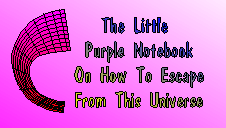
421216. Making the Ugly Look Gorgeous
This is a very basic exercise that has also a lot of practical uses in daily life.
Nowadays, the second variation would probably bring the contemplator into prison or the asylum. It is advisable to pick another item.
In these and similar exercises, care should be taken to end the exercises in a positive way, or, especially if it is REALLY an ugly thing one is looking at, the exercise could finish with a neutral perspective.
Fear, uncertainty, and a general whimpiness is leading many people to 'meditate' in groups. This is one of Gotamo's biggest 'no-nos' (cp. the section on 'No-Nos').
There are many good reasons for physical solitude while working on resolving one's case. These reasons are magnified if the 'group' members are knowing each other very well or if they are emotionally connected (like family members, for example).
An exception is a guided dialogue or process
(cp. Transformational Dialogues). Here a practitioner is literally part
of the loop. The more knowledge and experience a practitioner has, the
less susceptible he or she will be to the influences from the other person's
case. The practitioner should therefore have
a good basic training before guiding a dialogue and should avoid certain
'heavy' processes unless expertise in handling entities has been achieved.
For similar reasons as above, the practitioner should not be a family
member in order to avoid potential problems.
Optimally, the practitioner, being part of the loop, will achieve 'case
gain' during the process. Very often, the 'case gain' of the practitioner
exceeds that of the client.
The exercises below are explicitly described in the Pali Canon and are paraphrased for easier reading. A description of a simple havingness process was added.
Gotamo never used any form like "we are...", "you should...", "we cannot...", etc. Constructs like this have identity-forming properties and should be avoided even in casual talk as much as possible. It may be a bit unusual at first to see an exercise described in the form it is presented here but, hey, what the heck!
Variation 1:
A person sits alone near a beautiful scenery in nature and as comfortable as possible. (2,500 years ago, in lack of remote-controlled recliners with built-in shiatsu back massager, this has been the 'lotus' seat.)
The person now begins to perceive the scenery as exceedingly beautiful as long and as intensive as possible.
This was the good part!
Now the person proceeds to turn the picture of the beautiful scenery into the perception of the most ugly and disgusting piece of landscape ever to disgrace the surface of Mother Earth. Here it shows what a real guy can do!
The worse it gets, the better it works (as a process, of course)!
Now, at this point, certain people stop. Even
worse, they now go around and tell everybody, whether they want to hear
it or not, how terrible and horrifying life,
Universe, and Everything would be.
But I trust that the reader will not get overwhelmed by their own thoughts so easily, and will get on to either repeat step one or, even better, will end the session by step 3 and a basic 'havingness' process.
Step 3 consists of looking at the same scenery as a bunch of atoms that are structured in a way as to form a scenery in nature.
A basic 'havingness' process (described elsewhere)
could be touching the ground with the hands, breathing deeply, rubbing
one's face and similar movements that are bringing
the person back into 'reality' and making
the person feel it has a body.
Having mastered the above process, several variations are possible. For example, one can try to change perceptions of past viewpoints in a similar way (and to the better, I hope!!!) It is also possible to increase the speed (or frequency) of switching between 'ugly' and 'beautiful' perceptions of the same thing.
At a certain point the person may also get aware of HOW exactly the person is doing the switching. A facilitator or practitioner may want to induce this question (and be surprised by the variety of answers).
Now, this wasn't too bad, after all!
Here's the heavy stuff:
(Again, don't try this in today's civilization! There is enough other nasty stuff around - pick something else for Heaven's sake!)
A person sits down alone comfortably near a body of a person who has just kicked the bucket.
(In ancient India where credit cards were unknown at the time, deceased people with no money were not buried but put on a rack outside the village where 'nature' did the rest.)
The person now observes as many 'submodalities' as possible, such as colors, smell, etc, very carefully. Then, any perception of 'ugly' will be turned into 'beautiful' (and 'neutral'), similar to Variation 1.
As the person comes by once every day, it soon becomes REALLY ugly.
The skin turns blue, the smell makes one puke...
Well, better not go into details here...
After a week, the birds,rats, and worms will have had a couple of picknicks (no pun intended), and the skeleton is a somewhat easier item to confront, hmmm...
Obviously, this exercise is not for everybody...
Now, how can I end this chapter on a more positive note?
Hmm, well, I can't.
No, wait!!
Take this chapter of the 'Little Purple Notebook On How To Escape From This Universe' and, in your mind, make it appear even uglier than it already is!
Then, in your mind, turn it into the most beautiful piece of literature EVER written in history of mankind!
Make a check out to me, put it in an enveloppe with my readable (!) address, and don't forget to put a stamp on it!
Drop it in the next mailbox, lean back, and enjoy your wonderful karma!!!
(the latter exercise will give you a lot of Karma points - at least 500 times the amount on the check!)